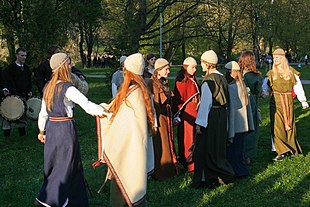|
Lithuanian folk musicLithuanian folk music is the traditional music of Lithuania, belonging to the broader category of Baltic music. Both stringed (kanklių) and wind instruments feature prominently. The folk music of Lithuania is archaic, with connections to Baltic paganism. Vocal music There are three ancient styles of singing in Lithuania connected with ethnographical regions: monophony, multi-voiced homophony, heterophony and polyphony. Monophony mostly occurs in southern (Dzūkija), southwest (Suvalkija) and eastern (Aukštaitija) parts of Lithuania. Multi-voiced homophony, widespread in entire Lithuania, is the most archaic in Samogitia. Traditional vocal music is held in high esteem on a world scale: Lithuanian song fests and sutartinės multipart songs are on the UNESCO's representative list of the Masterpieces of the Oral and Intangible Heritage of Humanity. Sutartinės (multipart songs) Sutartinės (from the word sutarti—to be in concordance, in agreement, singular sutartinė) are highly unique examples of folk music. They are an ancient form of two and three voiced polyphony, based on the oldest principles of multivoiced vocal music: heterophony, parallelism, canon, hocket, and free imitation. Most of the sutartinės' repertoire was recorded in the 19th and 20th centuries, but sources from the 16th century on show that they were significant along with monophonic songs. At present the sutartinės have almost become extinct as a genre among the population, but they are fostered by many Lithuanian folklore ensembles. The topics and functions of sutartinės encompass all major Lithuanian folk song genres. Melodies of sutartinės are not complex, containing two to five pitches. The melodies are symmetrical, consisting of two equal-length parts; rhythms are typically syncopated, and the distinctly articulated refrains give them a driving quality. Sutartinės can be classed into three groups according to performance practices and function:
Sutartinės are a localized phenomenon, found in the northwestern part of Lithuania. They were sung by women, but men performed instrumental versions on the kanklės (psaltery), on horns, and on the skudučiai (pan-pipes). The rich and thematically varied poetry of the sutartinės attests to their importance in the social fabric. Sutartinės were sung at festivals, gatherings, weddings, and while performing various chores. The poetic language while not being complex is very visual, expressive and sonorous. The rhythms are clear and accented. Dance sutartinės are humorous and spirited, despite the fact that the movements of the dance are quite reserved and slow. One of the most important characteristics of the sutartinės is the wide variety of vocables used in the refrains (sodauto, lylio, ratilio, tonarilio, dauno, kadujo, čiūto, etc.). Wedding songsDifferent vocal and instrumental forms developed, such as lyrical, satirical, drinking and banqueting songs, musical dialogues, wedding laments, games, dances and marches. War-historical time songsChronicles and historical documents of the 13th through 16th centuries contain the first sources about songs relating the heroics of those fallen in battle against the Teutonic Knights. Later songs mention the Swedes, there are frequent references to Riga and Battle of Kircholm; songs collected in the early 19th century mention battles with the Tatars. Songs from uprisings and revolutions, as well as anti-Soviet guerrilla resistance in 1945-1952 and deportation songs are also classified as wartime historical songs. Calendar cycle and ritual songsThey were sung at prescribed times of the year while performing the appropriate rituals. There are songs of Shrovetide and Lent, Easter swinging songs, and Easter songs called lalavimai. The Advent songs reflect the mood of staidness and reflection. Christmas songs contain vocables such as kalėda, lėliu kalėda; oi kalėda kalėdzieka, while Advent songs contain vocables such as leliumoj, aleliuma, aleliuma rūta, aleliuma loda and others. There are several typical melodic characteristics associated with Christmas ritual songs, such as a narrow range, three-measure phrases, dance rhythms, a controlled slow tempo, and a tonal structure based on phrygian, mixolydian or aeolian tetrachords. Polyphonic St. John's Feast songs are commonly called kupolinės, which include refrains and vocables such as kupolėle kupolio, kupolio kupolėlio, or kupole rože. Work songsWork songs vary greatly in function and age. There are some very old examples, which have retained their direct relation with the rhythm and process of the work to be done. Later work songs sing more of a person's feelings, experiences and aspirations. The older work songs more accurately relate the various stages of the work to be done. They are categorized according to their purpose on the farm, in the home, and so on.
Instrumental music The rateliai round dances have long been a very important part of Lithuanian folk culture, traditionally performed without instrumental accompaniment. Since the 19th century, however, fiddle, basetle, lamzdeliai and kanklės came to accompany the dances, while modern groups also incorporate bandoneon, accordion, concertina, mandolin, clarinet, cornet, guitar and harmonica. During the Soviet era, dance ensembles used box kanklės and a modified clarinet called the birbynės; although the Soviet ensembles were ostensibly folk-based, they were modernized and sanitized and used harmonized and denatured forms of traditional styles.[1] The most important Lithuanian popular folk music ensembles included Skriaudžių kanklės, formed in 1906, and Lietuva. Such ensembles were based on traditional music, but were modernized to be palatable to the masses; the early 20th century also saw the spread of traditional musical plays like The Kupiškėnai Wedding.[1]  Some of the most prominent modern village ensembles: Marcinkonys (Varėna dst.), Žiūrai (Varėna dst.), Kalviai-Lieponys (Trakai dst.), Luokė (Telšiai dst.), Linkava (Linkuva, Pakruojis dst.), Šeduviai (Šeduva, Radviliškis dst.), Užušiliai (Biržai dst.), Lazdiniai-Adutiškis (Švenčionys dst.). Some of the most prominent town folklore groups: Ratilio, Ūla, Jievaras, Poringė (Vilnius), Kupolė (Kaunas), Verpeta (Kaišiadorys), Mėguva (Palanga), Insula (Telšiai), Gastauta (Rokiškis), Kupkiemis (Kupiškis), Levindra (Utena), Sūduviai (Vilkaviškis). Children folk groups: Čiučiuruks (Telšiai), Kukutis (Molėtai), Čirulis (Rokiškis), Antazavė (Zarasai dst.)[1]. InstrumentsWind instruments : "Aerophones make up the richest and most varied group of traditional Lithuanian instruments", in three categories: flutes, reeds, and horns.[2]
String instruments : Percussion : See alsoReferences
|
